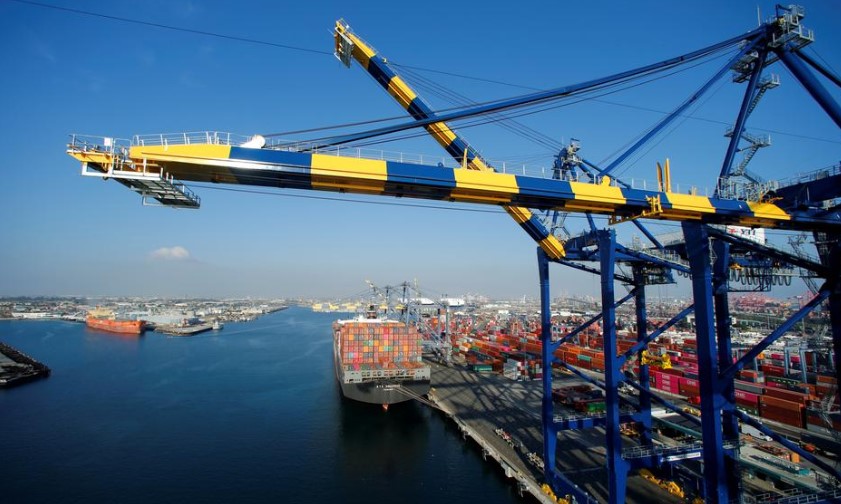
The U.S. goods trade deficit surged to a record high in 2018 as strong domestic demand fueled by lower taxes pulled in imports, despite the Trump administration’s “America First” policies, including tariffs, aimed at shrinking the trade gap.
President Donald Trump is pursuing a protectionist trade agenda to shield U.S. manufacturing from what he says is unfair foreign competition. Trump, who has dubbed himself “the tariff man,” pledged on both the campaign trail and as president to reduce the deficit by shutting out more unfairly traded imports and renegotiating free trade agreements.
The Commerce Department said on Wednesday that a 12.4 percent jump in the goods deficit in December had contributed to the record $891.3 billion goods trade shortfall last year. The overall trade deficit surged 12.5 percent to $621.0 billion in 2018, the largest since 2008.
“The trade deficit exploded last year despite the Trump administration efforts to make America great again, and the trend is unlikely to get any better in 2019,” said Chris Rupkeychief economist at MUFG in New York.
The White House has argued that reducing the trade deficit would boost annual economic growth to its goal of 3 percent on a sustainable basis. The government also sought to stimulate the economy with a $1.5 trillion tax cut package, which jolted both consumer and business spending, helping to lift imported goods to a record $2.6 trillion in 2018.
The United States last year imposed tariffs on $250 billion worth of goods imported from China, with Beijing hitting back with duties on $110 billion worth of American products, including soybeans and other commodities. Trump has delayed tariffs on $200 billion worth of Chinese imports as negotiations to resolve the eight-month trade war continue.
Businesses likely stocked up on imports in anticipation of further duties on Chinese goods, which ironically contributed to the deterioration in the trade deficit last year.
The goods trade deficit with China increased 11.6 percent to an all-time high of $419.2 billion in 2018. The United States, which also slapped duties on imported steel, aluminum, solar panels and washing machines, had record imports from 60 countries in 2018, led by China, Mexico and Germany.
“Perhaps Donald Trump will now discover that tweets and bluster alone won’t dramatically shrink the trade deficit,” said Scott Paul, president of the Alliance for American Manufacturing in Washington. “The administration’s fiscal policies have helped to boost the trade deficit.”
While goods exports hit a record $1.7 trillion in 2018, they declined in the last three months of the year, weighed by the U.S.-China trade dispute, slowing global demand and a strong dollar, which is making American-made goods less competitive on the international market.
The dollar was little changed against a basket of currencies, while U.S. Treasury prices rose. Stocks on Wall Street were trading lower as investors awaited fresh developments on the trade negotiations.
LABOR MARKET SLOWING
Economists expect exports to remain weak even if Washington and Beijing strike a trade deal.
“That will take time and if the Chinese growth is as soft as most economists believe, it is hard to see how they can ramp up demand for U.S. products very much this year,” said Joel Naroff, chief economist at Naroff Economic Advisors in Holland, Pennsylvania.
A 1.9 percent drop in exports of goods and services drove the trade deficit in December to $59.8 billion, the largest since October 2008. Imports of goods and services increased 2.1 percent to $264.9 billion in December.
When adjusted for inflation, the goods trade deficit surged $10.0 billion to a record $91.6 billion in December.
The jump in the so-called real goods trade deficit suggests that the drag from trade on fourth-quarter gross domestic product growth was probably bigger than the 0.22 percentage point estimated by the government last week. Economists expect the government will revise down fourth-quarter GDP growth to a 2.3 percent annualized rate from the 2.6 percent it reported last Thursday.
Other data on Wednesday suggested some slowing in the labor market, though the pace of job gains remains more than enough to drive the unemployment rate down. The ADP National Employment Report showed private payrolls increased by 183,000 in February after surging 300,000 in January. Economists polled by Reuters had forecast private payrolls advancing 189,000 in February.
The ADP report, which is jointly developed with Moody’s Analytics, was published ahead of the government’s more comprehensive employment report for February scheduled for release on Friday.
The ADP report is not considered a reliable predictor of the private payrolls portion of the government’s employment report because of differences in methodology.
February’s report was, however, in line with other labor market data, including weekly applications for unemployment benefits and manufacturing and services sector surveys that have suggested some moderation in job growth following hefty gains in January.
“It looks broadly consistent with our view that job growth remained solid in February despite cooling from the boomy figures reported for the prior several months,” said Daniel Silver, an economist at JPMorgan in New York.
According to a Reuters survey of economists, nonfarm payrolls likely increased by 180,000 jobs in February after jumping 304,000 in January. The unemployment rate is forecast falling to 3.9 percent in February from 4.0 percent in January.
